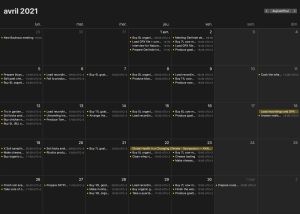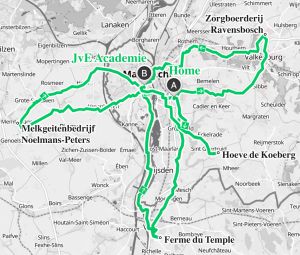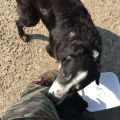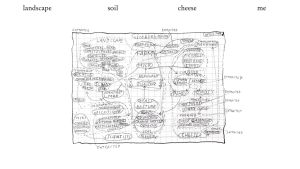Landscape, soil, cheese and me: Difference between revisions
| Line 22: | Line 22: | ||
| Melkgeitenbedrijf Noelmans-Peters || Riemst, BE || goat milk || Shop open Wednesday and Saturday 10-17 || José +32 495532390 || 1,5€/L | | Melkgeitenbedrijf Noelmans-Peters || Riemst, BE || goat milk || Shop open Wednesday and Saturday 10-17 || José +32 495532390 || 1,5€/L | ||
|} | |} | ||
====Gallery==== | |||
<gallery mode="traditional"> | <gallery mode="traditional"> | ||
File:04-07b.jpg| | File:04-07b.jpg| | ||
| Line 38: | Line 39: | ||
</gallery> | </gallery> | ||
<br><hr> | <br><hr> | ||
===Soil=== | ===Soil=== | ||
[[File:LandscapeSoilCheeseMe_soil-biota-scales.jpg|thumb|3 different scales of observation were used to see as much of the soils’ biota as possible: macro, meso and microscopic.]] | [[File:LandscapeSoilCheeseMe_soil-biota-scales.jpg|thumb|3 different scales of observation were used to see as much of the soils’ biota as possible: macro, meso and microscopic.]] | ||
Revision as of 19:33, 2 November 2021
Largely confined to the Jan van Eyck Academie during their residency, both Robin and Nickie from The Soft Protest Digest adopted an introspective approach orbiting questions of transition and self-sustenance in dire circumstances, such as pandemics and planetary crises.
Robin Bantigny has made and ripened cheeses from locally produced raw milk to serve daily for one month at the Café-Restaurant. He took pains to record his extensive cycling journeys around the region to dairy farmers, from whom he also collected soil samples to study their biota. These deliberative performative routines entangled him in the landscape’s rhythms of mutualism, growth, and decay.
A 1 month performance
Written at first person as Robin
During the month of April in the region of Limburg, I entangled myself in a network of beings, mutualism and trophic relationships of decay to produce cheese. By doing so, my ambition was to depict and project in other humans the network in which our primates’ life are tied in — whatever we make — and that makes “us” broader than only-humans.
Landscape
This web constituted by a space of ±50km2 area for a time of 30 days, tied me up with 4 Dutch and Belgian farmers that I have found through the landscape they live in. This same landscape provides pastures for their domesticated animals (cows and goats) to graze plants that they digest and transform into the milk that I purchased. On my way to each one of the 4 farms, I described the landscape. The landscape is the addition of living beings growing, hunting, socialising and working in the surroundings of the road network from home to farms (fields, buzards, sheds, trees, goose, ponds, crows, etc.)
| Farm name | Location | Milk type | Opening hours | Contact | Price |
|---|---|---|---|---|---|
| Hoeve de Koeberg | Sint Geertruid, NL | organic cow milk | Open from 8 to 8.45 and 18.30 to 19.30 when milking for milk | Claudia +31 655861399 | 1€/L |
| Ferme du Temple | Visé, BE | cow milk | 10-12.30 and 14-16.30, closed Tuesday and Sunday | +32 43797184 | 1€/L |
| Zorgboerderij Ravensbosch | Hulsberg, NL | organic goat milk | Better to come at 9am | Maurice +31 651492391 | 2€/L |
| Melkgeitenbedrijf Noelmans-Peters | Riemst, BE | goat milk | Shop open Wednesday and Saturday 10-17 | José +32 495532390 | 1,5€/L |
Gallery
- 06-10.jpg
Soil
I also extracted a small piece of soil from the pastures I got milk from. Along the purchased milk, this soil sample brought back home was “visited” with a microscope to look for living beings in these soils, reflecting on the decomposers’ primal activity to decay and recycle organic matter, the changes threatening their mutualism, and its analogy with the way microbe societies make cheeses.
Soil analysis of milk providers: 1 hectare grassland next to the farm's main barn.
- Trowel sampling: 16 small 10cm deep samples mixed together. 10 and 20g extracted and mixed with 100g demineralised water.
- Pitfall trap: one 365mL jar in the center of the pasture Baermann funnel.
Observations: Microscopic fungi and animals, macroscopic insects and worms crawling in samples.
Microscopic observations archives
Cheese
The cheeses were made with raw goat and/or cow milk from 4 farms in an area of ø40km around Maastricht. They were curdled with rennet to make uncooked soft cheeses. Half of the cheeses were ripened with various ferments (G. candidum, P. camemberti, P. roqueforti) and the other half developed the milks’ “wild” biota. They were aged for 1 week to 1.5 month in a cold moist room without any energy input.
Cheese production archives
- 🧀 The dedicated page for every cheese made during the performance
- 🧀 An experiment on designing an cheese that illustrates the local landscape
Me
A short film
In the start of September 2021, the collective was invited by the Food Art Film Festival 2021, run by the Food Lab of the Jan van Eyck Academie.
- 🎞🎥Landscape, soil, cheese and me — Short film (~10min)



















